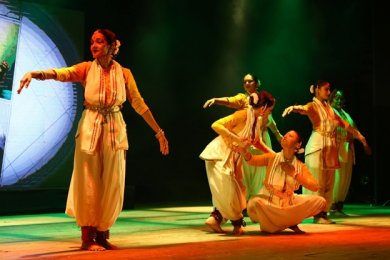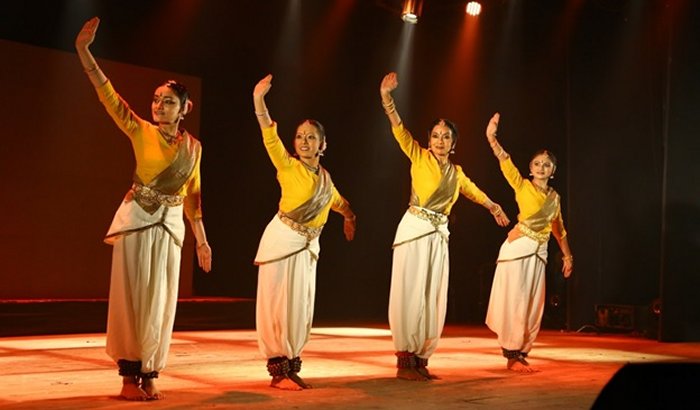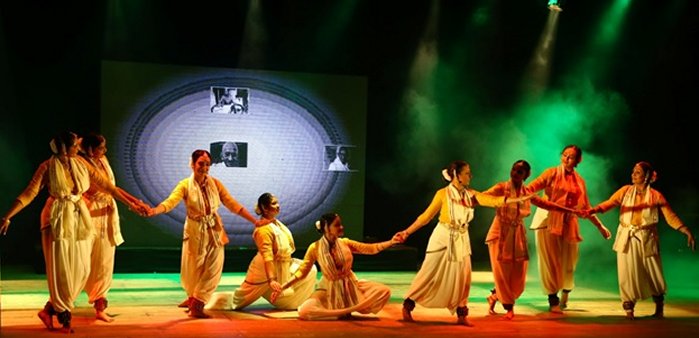
|   |

|   |
'Mahatma - An Eternal Spirit' combines intelligibility and aesthetics - Dr. S.D. Desai e-mail: sureshmrudula@gmail.com May 16, 2019 Bharatanatyam dancer Sharmishtha Sarkar of Aavirbhaav in her exquisitely conceptualized, scripted and choreographed, all singlehandedly in close to nine months with a diligent study, Mahatma - An Eternal Spirit proves that if you have the conviction of the ideas you wish to portray and an easy felicity in your art form with resourcefulness to appropriately call to aid other mediums and elements to portray them, it is possible to put across the loftiest of ideas combining intelligibility and aesthetics.  In depicting Mahatma Gandhi's values, the dance piece rises to the level of the significance of the event - commemoration of a century of existence of the Navjivan Trust, the publishing house he established (1929), and 150 years Gandhi-Kasturba phenomenon was born. It avoids chronology, specific historical events, opinions and trivia. Instead, from Gandhi's extraordinary life and work of epic dimensions, she separates and projects with suggestion the values he followed with success and in the process became a beacon of hope for generations to come.  In her 60-minute compact stage presentation, also directed by her, she has welcomed collaboration. Music composers Prathamesh Bhatt and Nishith Mehta with their creative inputs (the latter limited to one, Shrishti) complement her group dance beautifully at an even pace spread over eight sequences, each springing to life with a musical score and a sensitively rendered song, based on a classical raga, particularly by a senior disciple of Pt Jasraj, Neeraj Parikh and Ami Parikh. The visual design (Nirav, Mayur) as on a thick brownish khadi cloth with quickly changing montages of still images of events and persons including those of Gandhi himself, accompanied by a narration in Hindi (trans., Rekha Mukherjee) sometimes a song, and a one or two-line text, preparing the viewers for each sequence, is integral to the presentation. Within a minute of its initial sequence in a simple and chaste style following the choreographer's preamble to the piece in the same style in English, the tone is set and it remains sustained till the very end. The mood it evokes is of the fullness of life with the underlying thought of resisting ideas of greedy possessions with the Upanishad's pithy lines Eeshavasyam idam sarvam. The dancers' index finger pointing upward coincides with the rhythmic sound tat, which is heard echoing the eternal tad (eesh). The sound system (Kinnar Sound) and the lights (Parth Raval), both controlled, converge with the dance harmoniously and contribute to this sense of fullness.  One of the initial sequences is based on Tagore's Antara mama vikasita karo. A tiny jewel of a poem with its shorter vowel and softer consonant sounds praying for the awakening within is musically delectably composed with a medium-paced female vocal and notes on the veena supporting the mood of humble entreaty. Offering the extraordinary prayer, the dancers suggest slowly opening flower petals and the rising power of Kundalini on simple evocative words like nirmala karo, ujjwala karo, jaagruta karo hey! with their hasta-mudras, mukha-mudra and light movement. Later in Ahimsa, the combat is symbolically suggested in a few minutes with mudras and netrabhinaya as with white and red dupattas. Sequence after sequence keeps streaming in. Elevated thoughts are borne and pleasingly interpreted by the dancers, a few experienced (Manali, Purvi, Shaili, Mrinallini) and a few others modest, and felt in the auditorium by both, those having a belief in and those having a nodding acquaintance with them - empowerment through self-reliance, peaceful living, tolerance, compassion, Ahimsa, Satya, sarva-dharma-samabhaav and the like. For the complexity of the thoughts there could be seminars and conferences. Mahatma - An Eternal Spirit is a modest endeavour to lead the strife-ridden modern world, including India, to the path it has lost.  There is need to remove spelling errors, just a few, from the text flashed on the screen. Dr. S.D. Desai, a professor of English, has been a Performing Arts Critic for many years. Among the dance journals he has contributed to are Narthaki, Sruti, Nartanam and Attendance. His books have been published by Gujarat Sahitya Academy, Oxford University Press and Rupa. After 30 years with a national English daily, he is now a freelance art writer. |